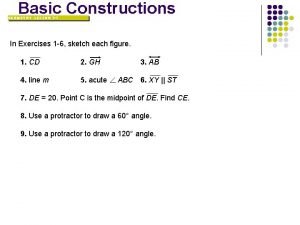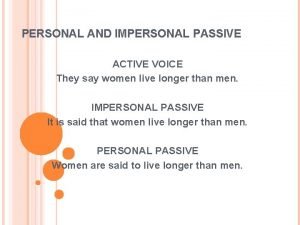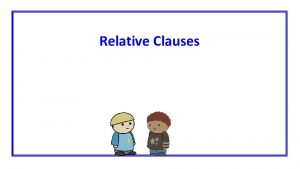Comparative Constructions II 9 Relative Clauses Relative Clauses











- Slides: 11

Comparative Constructions II # 9 - Relative Clauses

Relative Clauses Relative clauses are subordinate clauses that function as adjectives by modifying a noun or a noun phrase. Relative clauses: Contain a subject and a verb Begin with a relative pronoun or relative adverb Function as adjectives Relative clauses can be restrictive (i. e. , provide essential information) or non-restrictive (i. e. , provide additional information).

Restrictive vs. Non-Restrictive Relative Clauses: Restrictive relative clauses provide essential information. They are not set off by commas. e. g. , Do you know the girl who is talking to Sara? e. g. , The book (that) I read yesterday is interesting. Note: in restrictive relative clauses, the object relative pronoun may be dropped. Non-Restrictive Relative Clauses: They provide additional information They are set off by commas.

Relative Pronouns Who (subject or object - people): I told you about the woman who lives upstairs. Which (subject or object - animals and things): Do you see the cat which is hiding under the table. Which (to a whole sentence): He was late which surprised me. Whose (possession for people, animals, or things): I met the boy whose mother is the famous surgeon. Whom (object pronoun - people, especially in nonrestrictive relative clauses): I was invited by the teacher whom I met by chance. That (subject or object pronoun - people, animals, or things, in restrictive relative clauses): I bought the table that we eat on everyday.

Subject vs. Object Relative Pronouns If the relative pronoun is followed by a verb, it is a subject pronoun. In this case, the relative pronoun must be used. For example: I ate the apple which is lying on the table. If the relative pronoun is not followed by a verb (i. e. , by a noun or a pronoun), it is an object pronoun. In restrictive relative clauses, it may be omitted. For example: I ate the apple which Sara put on the table OR I ate the apple Sara put on the table.

Relative Adverbs Sometimes relative adverbs may be used instead of relative pronouns: When (in/on which - time): The day when we met them was an unforgettable day. Where (in/at which - place): The library where we study is more than 30 years old. Why (for which - reason): The reason why we study is to graduate.

Reducing Relative Clauses Relative clauses with the pronouns who, which, and that as subject pronouns can be reduced. For example: I told you about the girl who lives next door. I told you about the girl living next door. How to reduce relative clauses: Omitting the pronoun and the verb be: The ideas which are presented in that book are good. The ideas presented in that book are good. Omitting the pronoun and changing the verb into a participle -ing (when there is no verb be in the sentence): Anyone who wants to come with us is welcome. Anyone wanting to come with us is welcome.


Arabic vs. English The relative clause in both English and Arabic occurs after the noun/pronoun it modifies. In English, relative clauses may modify a definite or an indefinite noun. For example: The boy who plays football is sick. A boy who plays football is sick. In Arabic, relative clauses modify definite nouns only. For example: ﺭﺃﻴﺖ ﺍﻟﻮﻟﺪ ﺍﻟﺬﻱ ﻓﺎﺯ * ﻭﻟﺪ ﺍﻟﺬﻱ ﻓﺎﺯ ﺭﺃﻴﺖ

In Arabic, the relative pronoun agrees with the noun it modifies in number, gender, and case.

References Azar, B. S. (1999). Understanding and using English grammar (3 rd ed. ). New York: Pearson Education. Hamdallah, R. W. & Tushyeh, H. Y. (1998). A contrastive analysis of English and Arabic in relativization. Papers and Studies in Contrastive Linguistics, 34, 141 -152. http: //www. ego 4 u. com http: //www. drmosad. com/index 14. htm
 Stage 15 relative clauses and relative pronouns
Stage 15 relative clauses and relative pronouns Relative pronouns and relative clauses
Relative pronouns and relative clauses Yg prefab ltd
Yg prefab ltd Lesson 1-2 basic constructions
Lesson 1-2 basic constructions Rather construction
Rather construction What tools did the greeks use in geometric constructions
What tools did the greeks use in geometric constructions Nino constructions
Nino constructions Personal passive voice examples
Personal passive voice examples Reflexive verbs passe compose
Reflexive verbs passe compose Square edge constructions
Square edge constructions Lesson 10 unknown angle proofs
Lesson 10 unknown angle proofs Forays company
Forays company





















